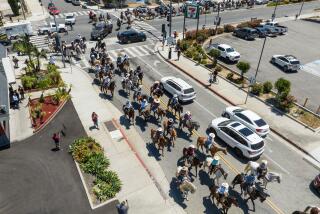Finally, a Stable Profession : Careers: Bret Roth turned to shoeing horses after being laid off from aerospace jobs. Now he doesn’t worry about the political winds.
- Share via
GLENDALE — In case the similarities between shoeing a horse and machining hydraulic brake components for the space shuttle weren’t clear, Bret Roth lifted the horse’s hoof and pointed out the thin, white line.
“Drive the nail in a sixteenth of an inch on the inside and you draw blood,” he said. “A sixteenth of an inch on the outside and the hoof splits.”
Hydraulic cylinders may be measured in thousandths of an inch, but that’s relative, Roth said. In the end, attention to detail is equally important in the two fields.
What’s different is job security.
In 1990, when the 36-year-old Toluca Lake resident was laid off for the second time, this time from his job as a hydraulics technician for Sterer Engineering in Burbank, he took his horse to have it shod. While that was happening, he had a minor epiphany.
“I was observing the shoers,” he said. “They were working and I wasn’t.”
He toiled away at a few more $5-an-hour jobs--in a futile wait for the aerospace industry to cease mourning the Cold War’s end--before making up his mind and heading East, to Bud and Kathie Beaston’s Oklahoma Farrier College outside the one-horse, four-stoplight town of Sperry.
“You wanna learn how to shoe horses, that’s the place to go,” Roth said Thursday afternoon, pounding a shoe across an anvil and into shape at Bar S Stables in Burbank.
Although he had “helped a guy pull a shoe once” and did own a horse, the lifelong Angeleno admitted to being a bit green upon his arrival at Bud and Kathie’s. They considered him a West Coast urbanite, likely to know more about palm trees than haystacks.
He spent seven months learning “the second-oldest profession,” which, according to a dusty text he keeps in a shed at Bar S, began not long after horses were first domesticated around 3000 BC. Then, the Persians and Egyptians began protecting their war horses’ battered hoofs by swathing them in grass and reeds.
Now, on a good day, he can service seven or eight horses--cleaning and trimming, filing and custom-fitting everything from aluminum jumping shoes to iron flat shoes. It’s backbreaking work, most often performed under a merciless Southern California sun, and brings in $55 or $60 per horse.
So why would a city dweller with $60,000-dollar-a-year experience in guided missile and satellite technology become a farrier?
Hunching over to file smooth the hoof of a restless mixed breed named Smiling Ed, Roth attempted to explain.
For one thing, he likes the creatures--”some better than others,” he said, and Smiling Ed here isn’t exactly a favorite--and he prefers working outside even on a hot day such as this one. But more than that, when he was unemployed, shoeing appeared to him a profession, “an art,” that had little to fear from the political turbulence that brought his employer and himself to their knees.
Even in Los Angeles, where horses may wear out their shoes trotting across movie lots instead of across the range, they need to be shod.
“I guess you could call it job security,” he said. “All the guys I knew that were shoeing horses . . . are still shoeing.”
More to Read
Inside the business of entertainment
The Wide Shot brings you news, analysis and insights on everything from streaming wars to production — and what it all means for the future.
You may occasionally receive promotional content from the Los Angeles Times.










